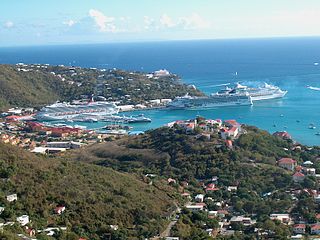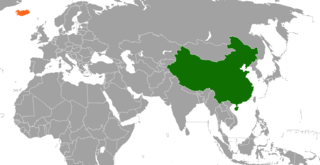
The economy of the British Virgin Islands is one of the most prosperous in the Caribbean. Although tiny in absolute terms, because of the very small population of the British Virgin Islands, in 2010 the Territory had the 19th highest GDP per capita in the world according to the CIA World factbook. In global terms the size of the Territory's GDP measured in terms of purchasing power is ranked as 215th out of a total of 229 countries. The economy of the Territory is based upon the "twin pillars" of financial services, which generates approximately 60% of government revenues, and tourism, which generates nearly all of the rest.

Reykjavík is the capital and largest city of Iceland. It is located in southwestern Iceland, on the southern shore of Faxaflói bay. Its latitude is 64°08′ N, making it the world's northernmost capital of a sovereign state. Reykjavík has a population of around 140,000 as of 2023. The Capital Region has a population of around 248,000.

The economy of the United States Virgin Islands is primarily dependent upon tourism, trade, and other services, accounting for nearly 60% of the Virgin Island's GDP and about half of total civilian employment. Close to two million tourists per year visit the islands. The government is the single largest employer. The agriculture sector is small, with most food being imported. The manufacturing sector consists of rum distilling, electronics, pharmaceuticals, and watch assembly. Rum production is significant. Shipments during a six-month period of fiscal year 2016 totaled 8,136.6 million proof gallons.

The demographics of Iceland include population density, education level, health of the populace, economic status, religious affiliations and other aspects of the population.
Icelandair is the flag carrier of Iceland, with its corporate head office on the property of Reykjavík Airport in the capital city Reykjavík. It is part of the Icelandair Group and operates to destinations on both sides of the Atlantic Ocean from its main hub at Keflavík International Airport. The geographical position of Iceland is convenient for one-stop transatlantic flights via the Atlantic Bridge route, which is one pillar of the airline's business strategy, along with traffic to, from, and within the country.
Tourism in Puerto Rico attracts millions of visitors each year, with more than 5.1 million passengers arriving at the Luis Muñoz Marín International Airport in 2022, the main point of arrival into the island of Puerto Rico. With a $8.9 billion revenue in 2022, tourism has been a very important source of revenue for Puerto Rico for a number of decades given its favorable warm climate, beach destinations and its diversity of natural wonders, cultural and historical sites, festivals, concerts and sporting events. As Puerto Rico is an unincorporated territory of the United States, U.S. citizens do not need a passport to enter Puerto Rico, and the ease of travel attracts many tourists from the mainland U.S. each year.

Tourism in Australia is an important part of the Australian economy, and comprises domestic and international visitors. Australia is the fortieth most visited country in the world according to the World Tourism Organization. In the financial year 2018/19, tourism was Australia's fourth-largest export and over the previous decade was growing faster than national GDP growth. At the time it represented 3.1% of Australia's GDP contributing A$60.8 billion to the national economy.

Cruise ships are large passenger ships used mainly for vacationing. Unlike ocean liners, which are used for transport, cruise ships typically embark on round-trip voyages to various ports of call, where passengers may go on tours known as "shore excursions". On "cruises to nowhere" or "nowhere voyages", some cruise ships make two- to three-night round trips without visiting any ports of call.

Reykjanesbær is a municipality on the Southern Peninsula (Suðurnes) in Iceland, though the name is also used by locals to refer to the suburban region of Keflavík and Njarðvík which have grown together over the years. The municipality is made up of the towns of Keflavík and Njarðvík and the village of Hafnir. The municipality was created in 1994 when the inhabitants of the three settlements voted to merge them into one. Reykjanesbær is the fourth largest municipality in Iceland, with 19,676 citizens (2021).

Keflavík Airport, also known as Reykjavík–Keflavík Airport, is the largest airport in Iceland and the country's main hub for international transportation. The airport is 1.7 nautical miles west of Keflavík and 50 km (30 mi) southwest of Reykjavík. The airport has three runways, two of which are in use, and the airport area is about 25 km2 (10 sq mi). Most international journeys to or from Iceland pass through this airport.

Akureyri Airport is a single-runway international airport in Akureyri, Iceland, 3 kilometres south of the town centre. Icelandair and Norlandair link the airport with several domestic locations, as well as easyJet, Edelweiss Air and Transavia serving seasonal international destinations. In the period 2009 to 2024 the airport has seen numerous improvements and expansions to better equip the airport for international flights. A new expanded passenger terminal is currently under construction, due to be completed by 2024.

Dubai is one of the world's leading tourism destinations, and tourism in Dubai is a major source of revenue. The city hosted 14.9 million overnight visitors in 2016. In 2018, Dubai was the fourth most-visited city in the world based on the number of international visitors.

Tourism is an economic contributor to the Kingdom of Thailand. Estimates of tourism revenue directly contributing to the GDP of 12 trillion baht range from one trillion baht (2013) 2.53 trillion baht (2016), the equivalent of 9% to 17.7% of GDP. When including indirect travel and tourism receipts, the 2014 total is estimated to be the equivalent of 19.3% of Thailand's GDP. The actual contribution of tourism to GDP is lower than these percentages because GDP is measured in value added not revenue. The valued added of the Thailand's tourism industry is not known. According to the secretary-general of the Office of the National Economic and Social Development Council in 2019, the government projects that the tourism sector will account for 30% of GDP by 2030, up from 20% in 2019,Thailand expects to receive 80 million visitors in 2027.

Tourism in Vietnam is a component of the modern Vietnamese economy. In 2019, Vietnam received 18 million international arrivals, up from 2.1 million in the year 2000. The Vietnam National Administration of Tourism is following a long-term plan to diversify the tourism industry, which brings foreign exchange into the country.

China–Iceland relations formally began on 8 December 1971, when Iceland recognised Beijing. Prior to the signing of a Free Trade Agreement between the two countries in 2013, diplomatic activities between them were relatively few in number. However, since this event, political cooperation has increased. There is growing number of economic and cultural ties, as their political partnership has expanded.

Kazakhstan is the ninth-largest country by area and the largest landlocked country. Tourism is not a major component of the economy. As of 2014, tourism has accounted for 0.3% of Kazakhstan GDP, but the government had plans to increase it to 3% by 2020.
Tourism impacts tourist destinations in both positive and negative ways, encompassing economic, political, socio-cultural, environmental, and psychological dimensions. The economic effects of tourism encompass improved tax revenue, personal income growth, enhanced living standards, and the creation of additional employment opportunities. Sociocultural impacts are associated with interactions between people with differing cultural backgrounds, attitudes and behaviors, and relationships to material goods. Tourism can also have significant political impacts by influencing government policies and promoting diplomatic relations between countries. Environmental impacts can be categorized as direct effects including environmental damage, wildlife destruction, deforestation, water pollution, and indirect effects, such as increased harvesting of natural resources to supply food, indirect air and water pollution. Tourism also has positive and negative health outcomes for local people. The short-term negative impacts of tourism on residents' health are related to the density of tourist's arrivals, the risk of disease transmission, road accidents, higher crime levels, as well as traffic congestion, crowding, and other stressful factors. In addition, residents can experience anxiety and depression related to their risk perceptions about mortality rates, food insecurity, contact with infected tourists, etc., which can result in negative mental health outcomes. At the same time, there are positive long-term impacts of tourism on residents' health and well-being outcomes through improving healthcare access positive emotions, novelty, and social interactions.

Overtourism is the congestion or overcrowding from an excess of tourists, resulting in conflicts with locals. The World Tourism Organization (UNWTO) defines overtourism as "the impact of tourism on a destination, or parts thereof, that excessively influences perceived quality of life of citizens and/or quality of visitor experiences in a negative way". This definition shows how overtourism can be observed both among locals, who view tourism as a disruptive factor that increasingly burdens daily life, as well as visitors, who may regard high numbers of tourists as a nuisance.

The COVID-19 pandemic has impacted the tourism industry due to the resulting travel restrictions as well as slump in demand among travelers. The tourism industry has been massively affected by the spread of coronavirus, as many countries have introduced travel restrictions in an attempt to contain its spread. The United Nations World Tourism Organization estimated that global international tourist arrivals could have decreased by 58% to 78% in 2020, leading to a potential loss of US $0.9–1.2 trillion in international tourism receipts.
A tourist tax is any revenue-generating measure targeted at tourists. It is a means of combating overtourism and a form of tax exporting. The tourist industry typically campaigns against the taxes. It is separate from value-added tax and other taxes that tourists may pay, but are also paid by residents.


















